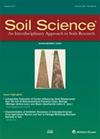Soil nutrient contents and stoichiometry within aggregate size classes varied with tea plantation age and soil depth in southern Guangxi in China
4区 农林科学
Q2 Agricultural and Biological Sciences
引用次数: 5
Abstract
Abstract. Soil ecological stoichiometry offers a tool to explore the distribution, cycling, limitation, and balance of chemical elements in tea plantation ecosystems. This study aimed to explore how soil organic C (OC) and nutrient contents (total N (TN), total P (TP), Ca2+, Mg2+, Fe2+, and Mn2+) as well as their stoichiometric ratios (C/N, C/P, N/P, Ca/Mg, and Fe/Mn) varied with tea plantation age (8, 17, 25, and 43 years) and soil depth (0–10, 10–20, 20–40, and 40–60 cm) within aggregates in southern Guangxi in China. Our results showed that tea plantation age and soil depth significantly affected soil nutrient stoichiometry in different sizes of aggregates. Among different ages of tea plantations, soil OC, TN, and TP contents as well as C/N, C/P, and N/P ratios significantly decreased as the soil depth increased. In addition, soil Ca2+ and Mg2+ contents were significantly lower in the surface soil layer than the deeper soil layer, whereas soil Fe2+ and Mn2+ contents showed opposite trends, and no significant differences were detected in Ca/Mg and Fe/Mn ratios among different soil depths. At the 0–40 cm soil depth, continuous planting of tea corresponded to increases in soil OC, TN, Fe2+, and Mn2+ contents, whereas soil Ca2+ and Mg2+ contents significantly decreased over time. During the process of tea growth, the losses of soil Ca2+ and Mg2+, especially Ca2+ (as indicated by the decrease in the soil Ca/Mg ratio), led to soil acidification, which reduced Fe2+ absorption and enhanced Mn2+ uptake by tea plants (as indicated by the increase in the soil Fe/Mn ratio). In general, tea plantation age affected the variations of soil nutrient contents and stoichiometry, and such effects were more obvious at the 0–40 cm soil depth, in contrast to the 40–60 cm soil depth.桂南茶园土壤团聚粒级的养分含量和化学计量特征随茶园树龄和土壤深度的不同而不同
摘要土壤生态化学计量学为研究茶园生态系统中化学元素的分布、循环、限制和平衡提供了工具。本研究旨在探讨桂南茶树团聚体土壤有机碳(OC)和养分含量(全N (TN)、全P (TP)、Ca2+、Mg2+、Fe2+和mn2 +)及其化学计量比(C/N、C/P、N/P、Ca/Mg和fe /Mn)随茶树树龄(8、17、25和43年)和土壤深度(0-10、10-20、20-40和40-60 cm)的变化规律。结果表明,茶园年龄和土壤深度对不同团聚体大小的土壤养分化学计量有显著影响。不同年龄茶园土壤有机质、全氮和全磷含量以及C/N、C/P和N/P比值随土壤深度的增加而显著降低。此外,表层土壤Ca2+和Mg2+含量显著低于深层土壤,而土壤Fe2+和Mn2+含量呈相反趋势,Ca/Mg和Fe/Mn在不同土壤深度间无显著差异。在0 ~ 40 cm土壤深度,连续种植土壤OC、TN、Fe2+和Mn2+含量增加,而Ca2+和Mg2+含量随时间显著降低。在茶叶生长过程中,土壤Ca2+和Mg2+特别是Ca2+的流失(表现为土壤Ca/Mg比值的降低)导致土壤酸化,从而降低茶树对Fe2+的吸收,增强茶树对Mn2+的吸收(表现为土壤Fe/Mn比值的增加)。总体而言,茶园树龄影响土壤养分含量和化学计量的变化,且这种影响在0 ~ 40 cm土壤深度更为明显,而在40 ~ 60 cm土壤深度则相反。
本文章由计算机程序翻译,如有差异,请以英文原文为准。
求助全文
约1分钟内获得全文
求助全文
来源期刊

Soil Science
农林科学-土壤科学
CiteScore
2.70
自引率
0.00%
发文量
0
审稿时长
4.4 months
期刊介绍:
Cessation.Soil Science satisfies the professional needs of all scientists and laboratory personnel involved in soil and plant research by publishing primary research reports and critical reviews of basic and applied soil science, especially as it relates to soil and plant studies and general environmental soil science.
Each month, Soil Science presents authoritative research articles from an impressive array of discipline: soil chemistry and biochemistry, physics, fertility and nutrition, soil genesis and morphology, soil microbiology and mineralogy. Of immediate relevance to soil scientists-both industrial and academic-this unique publication also has long-range value for agronomists and environmental scientists.
 求助内容:
求助内容: 应助结果提醒方式:
应助结果提醒方式:


